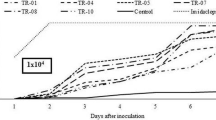Abstract
Neem [Azadirachta indica (A. Juss.)] seed oil (NSO) applied in three concentrations, 0.5%, 1% and 2%, to potted plants infested with green peach aphid,Myzus persicae (Sulzer), totally prevented adult eclosion of larval coccinellids,Coccinella undecimpunctata L., and reduced adult eclosion of syrphids,Eupeodes fumipennis (Thompson), to 11%, 7% and 0%, respectively, of the controls. Under the same conditions, NSO did not reduce the rate of parasitism ofM. persicae byDiaeretiella rapae (Mcintosh), but emergence of parasitoid adults from aphid mummies collected from treated plants was reduced to 35%, 24% and 0%, respectively, of the controls. Although topical treatment of predator larvae with NSO at concentrations of up to 5% did not affect survival, emergence of parasitoids from mummies dipped in aqueous emulsions of NSO at similar rates was reduced significantly. Under field conditions, sprays of NSO and neem seed extract to plants had no significant impact on the number of aphids parasitized. Although total numbers of predators were reduced, numbers of predators relative to aphid numbers were similar to those in controls. Neem insecticides may be suitable for use in integrated pest management programs, as under field use they appear to be relatively benign to aphid predators and parasitoids.
Similar content being viewed by others
References
Ascher, K.R.S. (1993) Nonconventional insecticidal effects of pesticides available from the neem tree,Azadirachta indica.Arch. Insect Biochem. Physiol. 22:433–439.
Feldhege, M. and Schmutterer, H. (1993) Investigations on side-effects of Margosan-O onEncarsia formosa Gah. (Hym., Aphelinidae), parasitoid of the greenhouse whitefiy,Trialeurodes vaporariorum Westw. (Horn., Aleyrodidae).J. Appl. Entomol. 115:37–42.
Frazer, B.D. (1988) Predators.in: Minks, A.K. and Harrewijn, P. [Eds.] Aphids, Their Biology, Natural Enemies and Control. Vol. 2B, pp. 217-230. Elsevier, New York, NY.
Hoelmer , K.A., Osborne, L.S. and Yokomi, R.K. (1990) Effects of neem extracts on beneficial insects in greenhouse culture.in: Locke, J.C. and Lawson, R.H. [Eds.] Neem’s Potential in Pest Management Programs, Proc. USDA Neem Workshop. USDA ARS-86, pp. 100-105.
Hsieh, C.Y. and Allen, W.W. (1986) Effects of insecticides on emergence, survival, longevity, and fecundity of the parasitoidDiaeretiella rapae (Hymenoptera: Aphidiidae) from mummifiedMyzus persicae (Homoptera: Aphididae).J. Econ. Entomol. 79:1599–1602.
Isman, M.B., Koul, O., Luczynski, A. and Kaminsky, J. (1990) Insecticidal and antifeedant bioactivities of neem oils and their relationship to azadirachtin content.J. Agric. Food Chem. 38:1406–1411.
Kaethner, M. (1991) Keine Nebenwirkungen von Niempräparaten auf die aphidophagen PrädatorenChrysoperla carnea (Steph.) undCoccinella septempunctata L.Anz. Schädlingskd. Pflanzenschutz Umweltschutz 64:97–99.
Klemm, U. and Schmutterer, H. (1993) Effects of neem preparations onPlutella xylostella L. and its natural enemies of the genusTrichogramma.Z. Pflanzenkr. Pflanzenschutz 100:113–128.
Lowery, D.T., Isman, M.B. and Brard, N.L. (1993) Laboratory and field evaluation of neem for the control of aphids (Homoptera: Aphididae).J. Econ. Entomol. 86:864–870.
McCloskey, C., Arnason, J.T., Donskov, N., Chenier, R., Kaminsky, J. and Philogène, B.J.R. (1992) Third trophic level effects of azadirachtin.Can. Entomol. 125:163–165.
Mohan, K., Gopalan, M. and Balasubramanian, G. (1991) Studies on the effects of neem products and monocrotophos against major pests of rice and their safety to natural enemies.Indian J. Plant Prot. 19:23–30.
Naumann, K., Currie, R.W. and Isman, M.B. (1994) Evaluation of the repellent effects of a neem insecticide on foraging honeybees and other pollinators.Can. Entomol. 126: 225–230.
Osman, M.Z. and Bradley, J. (1993) Effects of neem seed extracts onPholetestor (Apanteles) glomeratus L. (Hym., Braconidae), a parasitoid ofPieris brassicae L. (Lep., Pieridae).J. Appl. Entomol. 115:259–265.
Saxena, R.C. (1987) Neem seed derivatives for management of rice insect pests — a review of recent studies.in: Schmutterer, H. and Ascher, K.R.S. [Eds.] Natural Pesticides from the Neem Tree (Azadirachta indica A. Juss) and Other Tropical Plants.Proc. 3rd Int. Neem Conf. (Nairobi, Kenya), pp. 81-93.
Schauer, M. (1985) Die Wirkung von Nieminhaltsstoffen auf Blattläuse und die Rubenblattwanze. Ph.D. thesis, Univ. of Giessen, Germany. [Cited by Schmutterer, H. (1990) (ref. 17)]
Schmutterer, H. (1988) Potential of azadirachtin-containing pesticides for integrated pest control in developing and industrialized countries.J. Insect Physiol. 34:713–719.
Schmutterer, H. (1990) Properties and potential of natural pesticides from the neem tree,Azadirachta indica.Annu. Rev. Entomol. 35:271–297.
Schmutterer, H. (1992) Einfluβ von Azadirachtin, einer azadirachtinfreien Fraktion, eines alkoholischen Niemsamenextraktes und von formulierten Extrakten auf Verpuppung, Schlupf und Imagines der Kohlweiβlings-brackwespeApanteles glomeratus (L.) (Hym., Braconidae).J. Appl. Entomol. 113:79–87.
Schmutterer, H., Saxena, R.C. and Heyde, J. v.d. (1983) Morphogenetic effects of some partially-purified fractions and methanolic extracts of neem seeds onMythimna separata (Walker) andCnaphalocrocis medinalis (Guenee).Z. Angew. Entomol. 95:230–237.
Srivastava, S.K. and Parmar, B.S. (1985) Evaluation of neem oil emulsifiable concentrate against sorghum aphids.Neem Newsl. 2:7.
Stark, J.D., Wong, T.T.Y., Vargas, R.I. and Thalman, R.K. (1990) Survival, longevity, and reproduction of tephritid fruit fly parasitoids (Hymenoptera: Braconidae) reared from fruit flies exposed to azadirachtin.J. Econ. Entomol. 85:1125–1129.
Wilkinson, L. (1990) Systat: The System for Statistics. Systat Inc., Evanston, IL, USA.
Zar, J.H. (1984) Biostatistical Analysis. 2nd ed. Prentice-Hall, Inc., Englewood Cliffs, NJ, USA.
Author information
Authors and Affiliations
Rights and permissions
About this article
Cite this article
Lowery, D.T., Isman, M.B. Toxicity of neem to natural enemies of aphids. Phytoparasitica 23, 297–306 (1995). https://doi.org/10.1007/BF02981422
Received:
Issue Date:
DOI: https://doi.org/10.1007/BF02981422




